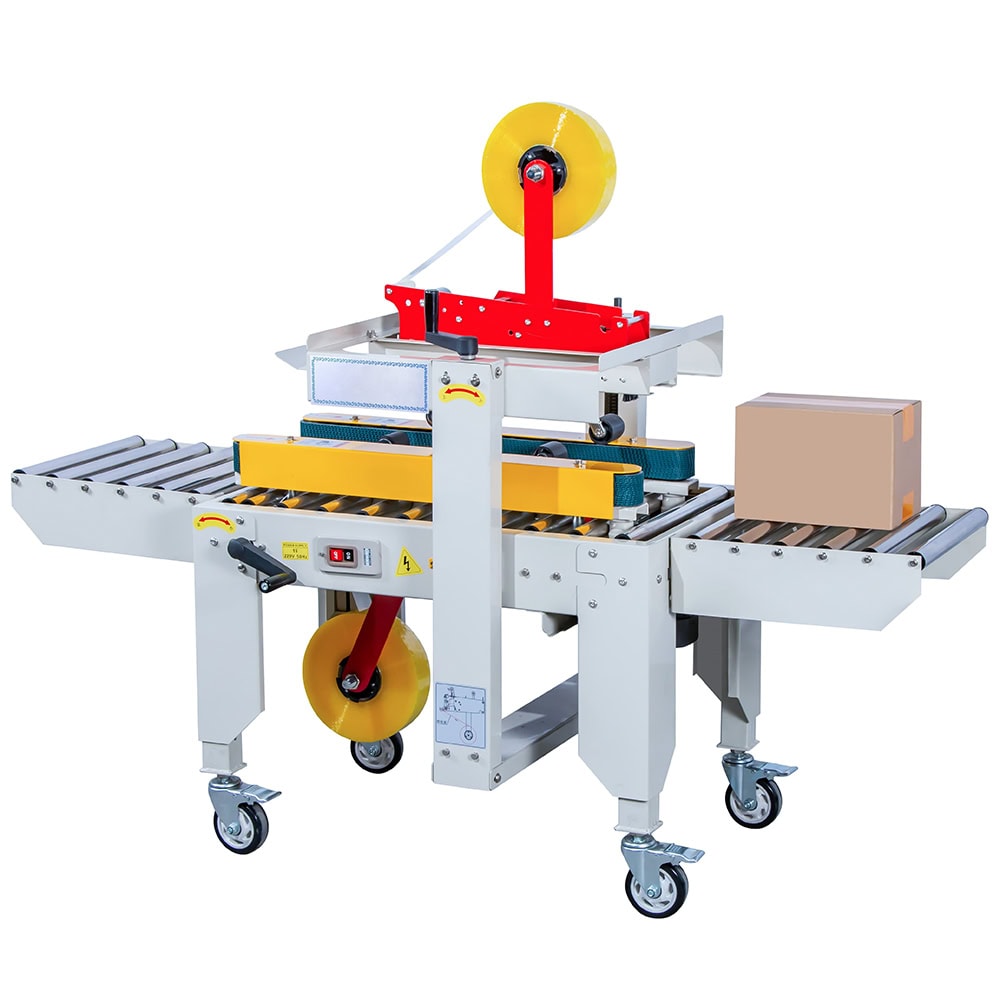If you don’t use it right, you’ll package things inefficiently, damage stuff, and be late with shipments. If you know how to use it, you’ll package things correctly, make fewer mistakes, and get more stuff done.
To run a carton sealer machine, you adjust the settings for box size, load the tape, and guide the box through the machine. It will apply tape to the top and bottom flaps automatically.
Let’s go through each step to make sure you can use your carton sealer machine.

What is a Carton Sealer Machine?
A carton sealer machine is a specialized piece of packaging equipment designed to automatically apply adhesive tape to cardboard boxes, sealing them for shipment or storage. These machines are common in industries that rely on efficient packaging, such as warehouses, manufacturing, and e-commerce.
There are two main types of carton sealers:
- Semi-automatic sealers: These require operators to feed the boxes manually into the machine. The machine then applies the tape and seals the box.
- Fully automatic sealers: These machines handle the entire sealing process without human intervention, making them ideal for high-volume operations.
How Does a Carton Sealer Machine Work?
A carton sealer machine operates by pulling a box through a series of rollers that apply adhesive tape to both the top and bottom flaps. It consists of adjustable mechanisms to accommodate various box sizes and ensure that the tape is applied evenly and securely.
- Automatic Mode: When set to automatic mode, the machine’s sensors detect the box and initiate the sealing process without requiring manual input.
- Tape Application: The machine dispenses a pre-set length of tape, applies it to the box’s flaps, and then cuts the tape for a clean, professional finish. The tape adheres securely, ensuring that the box remains closed during transit.
Step-by-Step Guide to Operating a Carton Sealer Machine
1. Setup
Begin by adjusting the machine’s height and width to match the dimensions of the box you will be sealing. Each machine has specific settings for box size, which ensures that the tape is applied in the correct position.
Next, load the tape reel onto the machine. Most carton sealers are designed to accommodate standard rolls of packing tape. Follow the manufacturer’s instructions to ensure the tape is installed properly and runs smoothly through the system.
Finally, run a test with an empty box to check that everything is properly aligned and adjusted.
2. Feeding the Box
Place the box on the machine’s conveyor belt. Make sure the box is aligned with the rollers to avoid misalignment during the sealing process. The machine will automatically pull the box forward once detected.
3. Sealing Process
As the box moves through the machine, the carton sealer will apply tape along the top and bottom flaps. The cutting mechanism will trim the tape to size once the box has been sealed.
Inspect the finished box to ensure the tape is securely applied and covers the seams evenly, preventing any openings or damage during shipment.
Safety Tips for Using a Carton Sealer Machine
When operating a carton sealer machine, safety is paramount. Always follow these guidelines:
- Wear protective gloves to avoid injuries from the machine’s cutting mechanisms.
- Regularly clean the blades and rollers to prevent tape buildup, which can lead to malfunctions or uneven sealing.
- Familiarize yourself with the emergency stop button, which immediately shuts down the machine in the event of a malfunction or safety hazard.
Common Carton Sealing Methods
Carton sealers offer a variety of sealing options, depending on your packaging needs:
- Top and Bottom Sealing: This is the most common method where the machine seals both the top and bottom flaps simultaneously.
- Single-Side Sealing: Some applications only require sealing on the top side, often for lighter boxes or specific packaging needs.
- Side Sealing: For irregularly shaped cartons, side sealing can be more effective, ensuring the box stays securely closed even when top and bottom sealing isn’t sufficient.
Troubleshooting Common Issues
Carton sealers, like any other machine, may encounter problems during operation. Here are some common issues and how to fix them:
1. Tape Misalignment
This can occur when the machine’s tape guide is improperly adjusted or worn. Recalibrate the guide and ensure the tape is feeding straight.
2. Inconsistent Seals
If the seal is weak or incomplete, it could be due to variations in box size or improper feeding. Standardizing box sizes and ensuring the box is fed straight through the machine can help resolve this issue.
3. Tape Breakage
Using low-quality tape or improper tension settings can cause the tape to break during operation. Always use high-quality adhesive tape designed for carton sealers and check tension settings regularly.
Maintenance and Best Practices
Regular maintenance is essential to keep your carton sealer running efficiently:
- Daily Cleaning: Remove any tape residue or dust from the machine’s blades and rollers after each use to avoid buildup.
- Inspect Blades and Rollers: Ensure they are sharp and in good condition for smooth tape application.
- Lubrication: Follow the manufacturer’s recommendations for lubricating moving parts, such as rollers and blades, to prevent friction and wear.
By maintaining your machine, you extend its lifespan and ensure consistent sealing quality, which is critical for reliable packaging.
Summary
Following these steps ensures efficient and safe use of your carton sealer machine, optimizing packaging processes and reducing downtime.
You may be interested in:









